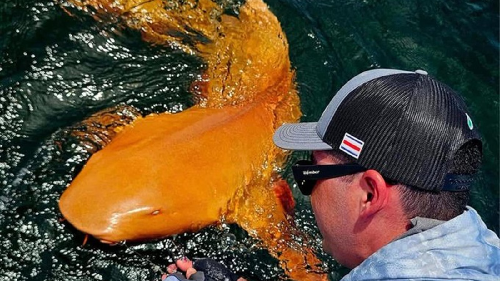A six-and-a-half-foot nurse shark with a striking bright orange body and eerie white eyes has been discovered off Costa Rica’s Caribbean coast, marking the first scientifically documented case of a fully xanthic shark in the world.
Sport fishers near the Parismina Limón Bar caught and released the unusual specimen in 2024, with photos and footage sparking global scientific attention after researchers published their findings in the journal Marine Biodiversity.
Scientists attribute the shark’s bizarre, vibrant colour to a rare combination of two distinct genetic mutations:
- Xanthism (or Xanthochromism): This is a pigment condition characterized by an excessive amount of yellow-to-orange pigmentation due to a lack of red pigment. While seen in some fish and reptiles, this is the first documented case of total xanthism in a cartilaginous fish species like the nurse shark (Ginglymostoma cirratum).
- Partial Albinism: The shark’s ghostly white eyes, which lack the typical dark irises, suggest a form of albinism, a condition caused by a deficiency in melanin. The co-occurrence of both conditions—termed albino-xanthochromism—is extremely rare in marine animals.
Nurse sharks are typically a muted yellowish-tan to grey-brown, relying on their colour for camouflage on the seabed.
The discovery is particularly significant because the bright orange shark is an adult, suggesting its unusual coloration did not hinder its survival. Animals with such obvious pigmentation abnormalities are often more visible to both predators and prey, which typically lowers their chances of reaching maturity.
The adult size of this shark has led scientists to speculate on factors that may have aided its survival, including the murky, sediment-rich waters near Tortuguero National Park, which may naturally offer some camouflage despite the colour.
The finding not only amazes the public but also opens new avenues for researchers to study the genetic and environmental factors, such as hormonal changes or rising ocean temperatures, that may be influencing pigmentation in vulnerable shark populations.
The rare sight of the orange shark was captured and released by sport fishermen, who followed proper catch-and-release protocols, allowing a truly unique animal to swim free.







